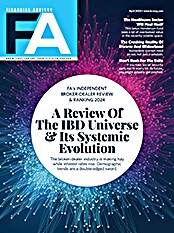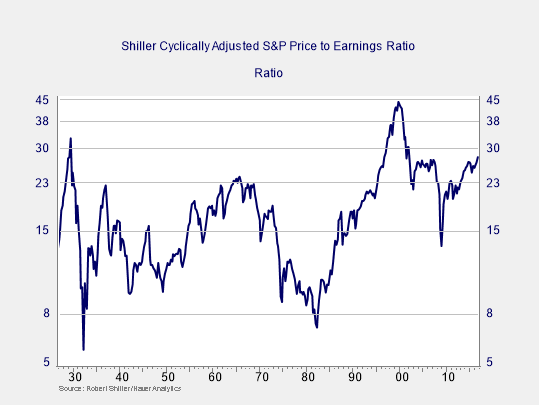I prefer to look at the cyclically adjusted P/E ratio, known as the Shiller P/E after the economist who popularized it, which uses average earnings over the past ten years to estimate the P/E. The idea is that a ten-year period captures both good and bad times, and as an average is a much better indicator of how the next ten years might look. No measure is flawless, but in my judgment, this is one of the best for our purposes today.
When we look at the Shiller P/E, we see a couple of things. First—and unlike the indices themselves—we are not at all-time highs. That gives us a measure we can use to help determine an upward limit.
Less reassuringly, that upward limit (above where the market is right now) has only two data points: in 1929 at 32.56 and in 1999 at 44.20. The current level, at 27.93, is above every other time except those two. Market valuations in 2007 at 27.42 came close, but we are now past them.
Two conclusions
We could have quite a bit of upside left to go. Were markets to match the 1999 valuation, they could appreciate almost another 60 percent, which would take the Dow to over 30,000 and the S&P 500 to over 3,500. Were markets to move up “just” to 1929 levels, we could see markets rise by about 16 percent, leaving the Dow at over 24,000 and the S&P 500 at over 2,700. These are the next limits, and the only real technical ones, for the markets. We could have quite a bit of upside left to go.
Very high valuation levels have historically led to high levels of risk once the exuberance subsides. Recently, I’ve written about the returns we can expect in the future, noting that high prices tend to mean lower future returns. The more prices rise, the worse future returns can be. This is why the 1929 and 2000 comparison are concerning. In those cases, we definitely saw lower future returns after the run-up, and the future might well be the same from here.
In the short run, there’s no reason markets can’t keep going, and we should enjoy the ride. It may end up being even better than we now think. The faster and higher we go, however, the more damaging any pullback could be. Keep that in mind as you celebrate the new records.
Brad McMillan is the chief investment officer at Commonwealth Financial Network, the nation’s largest privately held independent broker/dealer-RIA. He is the primary spokesperson for Commonwealth’s investment divisions. This post originally appeared on The Independent Market Observer, a daily blog authored by McMillan.









